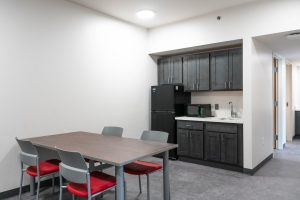Conservatory Opens New Performance Space
October 11, 2013
The David H. Stull Recital Hall, a new performance space located on the third floor of Bibbins Hall, continues to spark discussion on the how the allocation [more like the allocators] of Oberlin’s budget has a reputation for disregarding student needs. The performance space, which opened its doors to students and faculty on Oct. 1, will function as an additional site for performances and educational opportunities within the Conservatory.
“We combined two classrooms to turn it into a hall that’s very different from any other hall we’ve got,” said Andrea Kalyn, the acting dean of the Conservatory. “It’s not as big as Kulas [Hall] … this is a really flexible space. We can do classes in there, performances, ensembles, chamber music, master classes, recitals, studio classes,” she said.
According to Dean Kalyn, the creation of a new performance space become a priority when a classroom on the second floor that previously functioned as a mini-performance space was “compromised” after being renovated to make it compliant with the Americans with Disabilities Act.
“The need for performance spaces is always increasing,” Dean Kalyn asserted. “Students are always wanting more performance spaces.”
However, some student activists are displeased with the Conservatory allocating money to a project they see as nonessential.
“There are already a lot of performance spaces on campus; what there really aren’t are students and faculty of color and low-income students in the Conservatory program,” said double-degree junior Arianna Gil, a member of the Conservatory Student Working Group.
Two of the most substantive proposals put forth by the working group were the creation of a Multicultural Resource Center outpost in the Conservatory and a “strategic plan … to significantly improve our admissions yield and retention of students of color, as well as first-generation, LGBTQ, and low income students.”
Gil said that the latter proposal “implies allocation of funds” for scholarships aimed at making the Conservatory more accessible to low-income students.
Dean Kalyn said that the Conservatory was working with the MRC on having MRC office hours in the Conservatory, but Gil said she hadn’t seen any funds allocated for the permanent outpost that the student proposals envisioned.
“We know this school has so much money,” said Gil. “And whenever they say ‘We don’t have the money,’ that’s their way of saying ‘This isn’t important to us.’”
Gil said that a contractor who worked on the project told her that the performance space cost $2.5 million; Dean Kalyn said that that figure was incorrect. While Dean Kalyn said she didn’t know the cost of the performance space by itself, she did say that starting in 2011, the Conservatory has received approximately $2 million every summer to renovate Bibbins floor by floor. According to Dean Kalyn, the money for the performance space came out of that budget.
“This isn’t money that was funneled away from anything else into facilities; that’s a wholly separate budgeting process,” said Dean Kalyn. “You have to have facilities in which to teach, and this is a core teaching thing.” She also said that most of the $2 million budget to renovate Bibbins went to replacing the inefficient and outdated windows and not to the performance space.
The hall is named after David Stull, the former dean of the Conservatory who left last year to become president of the San Francisco Conservatory of Music. According to Dean Kalyn, “ [the space was] really kind of his idea … so when he announced he was leaving, the faculty knew they wanted to do something to honor him, and they wanted to name a space, but they wanted a space that was really part of the core of what we do and reflected his work … so the faculty asked that it be named after him.”
Because the space has only been open for a very short time, not many Conservatory students have yet had an opportunity to use it. Double-degree first-year Ellyn Butler, a student in Prima Vista, a class for first-year woodwind students, said she had used the space with her class.
“It’s really beautiful,” she said. “It has nice acoustics and really good lighting — it has tons of natural sunlight. The only problem is that because there is so much natural light in there, when it’s hot out it’s really hot in there.” Butler said that she thinks the small space will be useful for student recitals, as Kulas Hall is often too big for the audience that attends recitals.
“It does serve a purpose that they didn’t have before,” she said. “They didn’t have that size performance space before. So was it worth it? I don’t know, but it’s nice.”

























